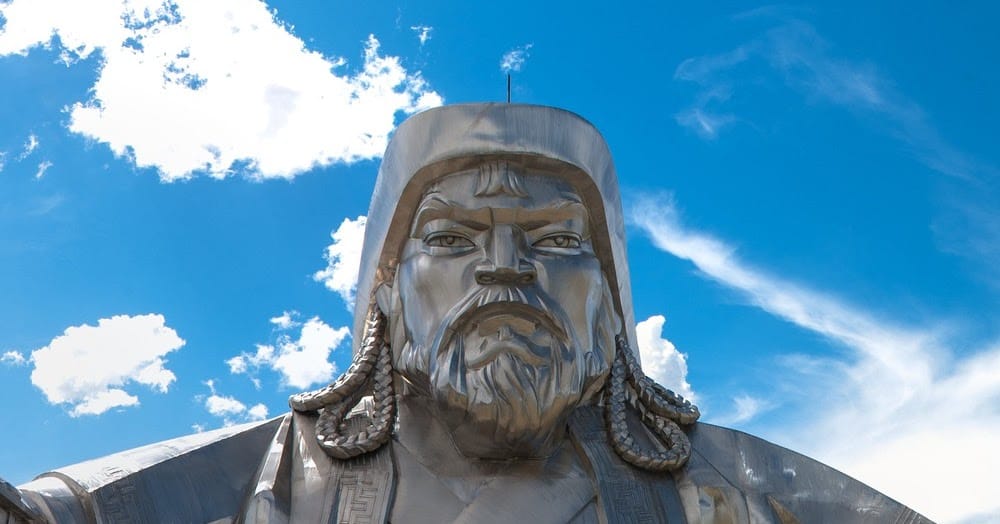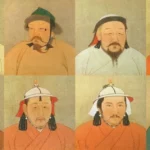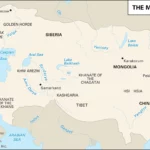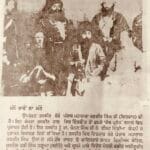Picture this: archaeologists on a daring mission to uncover the hidden tomb of Genghis Khan, a legendary warrior who ruled a vast empire centuries ago. For ages, his tomb has been a tantalizing secret, locked away from the world. But now, armed with clues and ancient tales, these adventurers are determined to crack the enigma and finally reveal the secrets of Khan’s final resting place. Get ready for a thrilling journey into the depths of history, where we’ll unravel the mystery that has captivated explorers for generations.
Tomb of Genghis Khan
Genghis Khan, the fierce warrior who united Mongol tribes and forged a vast empire, rests in a place unknown. This mystery is as old as time itself, or at least as old as Khan’s passing in 1227. He wanted it this way, instructing his loyal followers to keep his final resting place a secret. And did they ever succeed!
There are no grand pyramids, no towering mausoleums, no convenient “X marks the spot” on ancient maps. It’s like they wiped his existence off the map, at least the part that comes after his last breath. We know he was laid to rest somewhere near Burkhan Khaldun Mountain, a place sacred to the Mongols. This majestic peak, shrouded in legends and whispering winds, stands as a silent sentinel, guarding the secrets of the Khan’s tomb.
Some experts believe that Khan’s tomb lies hidden beneath the mountain itself, tucked away in a secret chamber. Others speculate that his funeral procession took a winding path designed to confuse anyone trying to follow. Imagine a massive entourage, traversing vast steppes and valleys, leaving no trace of their passage. It’s like something out of an adventure novel!
Over the centuries, many brave souls have embarked on quests to unearth the Khan’s tomb. Advanced technology, like ground-penetrating radar and satellite imagery, has been employed, but the earth holds its secrets tight. The mystery endures, fueling our imaginations and reminding us of the power of history’s unsolved puzzles.
The missing tomb is more than just an archaeological enigma; it’s a testament to the Mongols’ deep respect for their leader and their traditions. It’s a story whispered on the wind, a riddle etched in the very landscape of Mongolia, a mystery waiting to be unraveled.
If you’re interested in expanding your knowledge of history, Lola offers a comprehensive collection of engaging learning resources to immerse yourself in.
Has the Tomb of Genghis Khan Been Found?
The short answer? No. The tomb of Genghis Khan remains undiscovered, shrouded in mystery and protected by centuries of speculation and cultural reverence.
Genghis Khan, the fierce leader who united Mongol tribes and built an empire, made it clear he didn’t want a flashy burial. He wanted his final resting place kept top secret. His loyal followers, honoring his dying wish, took the location of his tomb to their own graves.
Over the years, many have embarked on quests to find this elusive tomb. Explorers and researchers have employed high-tech gadgets, from satellite imagery to ground-penetrating radar. But Mongolia’s massive and sparsely populated landscape throws a wrench in the works. It’s like trying to comb through a giant, wild, and untamed backyard.
Adding to that the tough terrain and weather conditions, searching for Genghis Khan’s tomb becomes a real-life treasure hunt worthy of Indiana Jones.
There are whispers and theories, though. Some experts think the Mongols were masters of disguise, cleverly hiding the tomb or removing any trace of it. Imagine booby traps and secret passages—talk about an adventure!
Others believe that to truly protect the tomb from grave robbers, they went for a “hide in plain sight” approach. Picture this: thousands of horses thundering over the burial ground, obliterating any sign of a tomb. It’s a bold move, but hey, when you’re dealing with a legacy as big as Genghis Khan’s, you don’t take any chances.
The mystery of Genghis Khan’s tomb isn’t just about finding a bunch of old bones. For the Mongolian people, it’s a matter of deep respect for their legendary leader. They believe disturbing his rest would bring bad luck and disrespect his spirit—a clash between historical curiosity and cultural reverence.
But the search isn’t over. As technology keeps advancing, who knows what we might uncover? Maybe one day, we’ll have the tools to discover the tomb without disturbing it. And if that day comes, be prepared for a history lesson like no other.
Did Archaeologists Unearth the Tomb of Genghis Khan?
Despite countless expeditions and relentless searching, the exact spot where Genghis Khan was laid to rest remains a secret. It’s like trying to find a needle in a haystack, but instead of a haystack, it’s the vast expanse of Mongolia!
The careful hiding of Genghis Khan’s tomb is deeply entwined with Mongolian traditions and the mysterious customs surrounding his death. His devoted army, honoring his wish for secrecy, paraded a thousand horses over his grave, effectively erasing any visible signs of its location. Even Marco Polo, the famous explorer who traveled through Mongolia back in the 13th century, wrote that the Mongols themselves didn’t know where the tomb was. Talk about a well-kept secret!
Over the years, there have been serious attempts to locate the tomb. Archaeologists have used cutting-edge technology and poured over old historical accounts. The National Geographic team, for instance, used satellite imagery to scan the Valley of the Khans for any sign of the gravesite. Other expeditions have meticulously combed through the landscape, scrutinizing every nook and cranny while analyzing historical texts for any hints. But despite all this effort, the tomb’s location remains a puzzle, hidden in the mists of time.
The Mongolian people hold Genghis Khan in the highest esteem. He’s a national hero, a symbol of their cultural heritage. There are even superstitions and beliefs intertwined with keeping his tomb a secret. Many Mongolians believe that disturbing it would unleash terrible consequences. The Mongolian government, understanding the cultural importance of all this, has actively supported the efforts to preserve the tomb’s secrecy.
Adding to the challenge is the sheer size and untouched nature of Mongolia. Imagine searching for something in a place bigger than Texas and California combined with a sparse population and limited infrastructure—it’s a logistical nightmare! And to top it all off, the tomb is probably located somewhere deep in the vast wilderness, making the search even more difficult.
However, the pursuit of Genghis Khan‘s tomb continues to captivate researchers and historians. It’s a tantalizing mystery that begs to be solved. Future archaeological digs might focus on deciphering old manuscripts and historical accounts, hoping to find clues about the tomb’s whereabouts. New technologies, like ground-penetrating radar, could offer a glimpse beneath the surface and help narrow down the search. And collaborating with Mongolian scholars and cultural experts could provide invaluable insights, respecting cultural sensitivities while unraveling this historical enigma.
Here’s what we know so far:
- Genghis Khan’s tomb remains undiscovered, cleverly hidden by his loyal army to ensure its secrecy.
- Mongolian cultural beliefs and deep respect for Genghis Khan’s wish for a hidden tomb make finding it a delicate matter.
- Mongolia’s vast and undeveloped landscape makes the search for the tomb challenging for archaeologists.
- Future research and technological advancements, combined with respect for Mongolian culture, could one day lead to the discovery of this historical treasure.
What Happened to the Guards Who Buried Genghis Khan?
The lengths taken to keep Genghis Khan’s final resting place a secret extended beyond just hiding a tomb; it involved erasing any trace of those who knew its location. Imagine being part of the group tasked with burying the legendary Khan—a tremendous honor, but also a terrifying burden.
After the burial was complete, the soldiers responsible for protecting the site weren’t just dismissed and sent home. They were killed, most likely to ensure absolute secrecy.
And it didn’t stop there. This pattern of eliminating anyone who might have knowledge of the tomb’s whereabouts continued in a chillingly systematic way. The executioners who carried out these killings? They were the next to be silenced, meeting the same fate as those they had just executed. This brutal efficiency speaks volumes about the lengths to which those in power were willing to go to protect the sanctity of Genghis Khan’s grave.
Adding to the enigma, fascinating legends and stories surround the specifics of Genghis Khan’s burial. Some say a river was diverted to flow over the grave, washing away any visible markers. Others claim that horses were ridden over the site, obliterating any signs of disturbance. There’s even a tale suggesting a baby camel was buried alongside the Khan, its mother later used by his family to locate the grave. These stories highlight the enduring mystery and fascination surrounding Genghis Khan’s final resting place.
While the exact location remains unknown, many scholars believe Genghis Khan was laid to rest near Burkhan Khaldun, a mountain sacred to the Mongols. This belief stems from the historical and cultural significance the mountain holds within Mongol tradition, making it a fitting final resting place for their most revered leader. However, with no confirmed discovery of the tomb, the search continues, fueled by both historical curiosity and the tantalizing possibility of untold treasures buried within.
The story of the guards and their grim fate is a chilling reminder of the power Genghis Khan wielded, even in death. The lengths to which his successors went to safeguard his burial site speak volumes about his lasting influence and the reverence he commanded. It also underscores the enduring mystery surrounding his final resting place—a mystery that continues to captivate and intrigue us centuries later.
How Many Died From Genghis Khan?
Trying to pin down exactly how many people died as a direct or indirect result of Genghis Khan’s conquests is like trying to count grains of sand on a beach—it’s a huge, daunting task!
Historians often estimate that somewhere between 20 to 40 million deaths occurred. To put that in perspective, imagine 5% to 10% of everyone alive on the planet today suddenly gone—that’s the kind of scale we’re talking about. And these figures aren’t just about those who fell in battle. Imagine entire regions thrown into chaos, crops destroyed, and trade routes disrupted—famine and disease would have swept through the land, claiming countless more lives.
It’s important to remember that getting a truly accurate count is probably impossible. We’re talking about events that happened centuries ago, and detailed records from that time are incredibly rare. Historians are like detectives piecing together a puzzle, using bits of archaeological evidence and whatever historical accounts they can get their hands on. They’re constantly refining their methods and looking for new clues to get a clearer picture of the impact of Mongol rule.
Even with the difficulty of getting exact numbers, one thing is crystal clear: Genghis Khan’s campaigns were absolute game-changers. The 13th and 14th centuries saw massive shifts in population, cultural practices, and even the political landscape, all echoing the might of the Mongol Empire.
Think about that—trying to grasp the ripple effects of events from so long ago! It makes you realize how interconnected everything is, and how much we still have to learn about our own history.
Want to dive deeper? Check out this book:
- Weatherford, J. (2004). Genghis Khan and the Making of the Modern World. New York: Three Rivers Press.
Why Did Genghis Khan Not Want His Grave to Be Found?
Genghis Khan was incredibly secretive about where he wanted to be buried. Even today, no one has found his tomb, and that was exactly how he wanted it. So why did Genghis Khan go to such lengths to keep his final resting place a secret?
Some experts believe it has to do with traditional Mongolian beliefs. Back then, people thought that disturbing the graves of their ancestors would bring bad luck. This idea probably weighed heavily on Genghis Khan’s mind. He wanted to make sure his spirit could rest peacefully and wouldn’t come back to haunt anyone!
But there might have been more practical reasons, too. Genghis Khan had plenty of enemies. He conquered vast territories and likely made some powerful rivals along the way. Hiding his tomb also protected it from anyone who might want to desecrate it out of revenge or steal any treasures buried with him.
The secrecy surrounding his tomb also served as a constant reminder of his power. Genghis Khan wasn’t just a ruler; he was seen as almost godlike by some. The fact that he could vanish without a trace, even in death, just added to his mystique and made people even more fearful of challenging his legacy.
There’s even a theory that Genghis Khan’s decision might have been influenced by ancient prophecies or legends. These stories might have warned about terrible things happening if his tomb were ever found. Whether he truly believed these prophecies or not, it’s easy to see how they could have reinforced his desire to keep his burial place a complete secret.
Even though we don’t know for sure where Genghis Khan is buried, all of these theories give us a glimpse into the mind of this legendary leader. They show us how important it was to him to uphold traditions, protect his empire, and solidify his power, even after death. The search for his tomb continues to capture our imaginations, and maybe someday, we’ll finally uncover the truth behind its mysterious location.
Does Mongolia Have a Forbidden Zone?
You bet it does! And it’s shrouded in as much mystery as the Mongolian steppe itself. This forbidden territory, known as Ikh Khorig, isn’t marked on any tourist map, and for good reason. It’s not your average national park; it’s believed to be the final resting place of the legendary Genghis Khan. We’re talking about a swathe of land approximately 240 square kilometers, a mix of towering mountains, winding rivers, and seemingly endless grasslands, all wrapped up in an air of secrecy and intrigue.
The hush-hush about entering Ikh Khorig boils down to deep-seated respect and a healthy dose of superstition. The Mongolian people hold Genghis Khan in high regard, almost as a deity, and believe that disturbing his eternal slumber would be a grave offense, bringing down untold misfortune upon their land. This belief, this “Great Taboo,” has been passed down through generations like a sacred oath, ensuring that the exact whereabouts of his tomb remain a secret known only to a select few.
But Ikh Khorig isn’t just about guarding a tomb; it’s a living, breathing sanctuary of spirituality. It’s where Mongolian shamans perform ancient rituals, paying homage to the spirit of Genghis Khan, keeping his memory and legacy alive. Think of it as a powerful testament to the unbreakable bond between the Mongolian people and their legendary leader, a bond that transcends the boundaries of time.
Ikh Khorig embodies the very essence of Mongolian cultural identity. It speaks volumes about their deep reverence for tradition, their connection to the land, and the enduring enigma that is Genghis Khan. It’s a tangible link to their nomadic past, a reminder of the warrior king who united the tribes and forged an empire.
The Mongolians believe that the afterlife should mirror the untamed wilderness, pure and untouched. This belief might explain why Genghis Khan’s burial site, even if found, might hold little in the way of glittering treasures. The man was known for his simple lifestyle and aversion to opulence, so his tomb might reflect that same austerity.
There’s still so much we don’t know about Ikh Khorig and the secrets it holds. Further exploration into its spiritual significance could reveal a treasure trove of insights into the Mongolian worldview. Who knows what mysteries lie hidden beneath the surface, waiting to be uncovered with respect and understanding?
Why Did the USSR Try and Wipe Out Genghis Khan’s Memory?
The Soviet Union clamped down on any whispers of Genghis Khan because they were afraid of the potential for Mongolian nationalism.
Genghis Khan embodied Mongolian national pride and strength. When the Soviets took control of Mongolia, they feared that allowing people to remember and celebrate this powerful figure from their past would stir up a desire for independence. To the Soviets, Genghis Khan represented a threat to their power.
To keep Genghis Khan’s memory under wraps, the Soviets went to extreme lengths. They tore down his statues and monuments, physically erasing him from the landscape. They went as far as ripping his name out of history books and school textbooks, hoping to make the younger generation forget all about him. They even persecuted people who dared to speak his name or celebrate his legacy. It was a systematic attempt to control the narrative and keep a lid on any potential uprisings.
But you can’t just erase culture and history. Despite the Soviet Union’s best efforts, Genghis Khan’s image and what he represented proved too strong to be wiped away. He was already deeply embedded in Mongolian culture and identity. His legacy, like family stories and traditions passed down through generations, had a life of its own.
In a way, the Soviets’ efforts backfired. By trying so hard to suppress Genghis Khan, they might have inadvertently made him an even more potent symbol of resistance against their rule.
Once the Soviet Union crumbled, Mongolia was free to reclaim its own narrative. Genghis Khan went from being a forbidden figure to a celebrated national hero almost overnight. Statues were rebuilt, his name was restored to its rightful place in history books, and his image started appearing everywhere. It was a powerful way for Mongolians to reconnect with their past and celebrate their cultural identity after decades of being suppressed.
The story of Genghis Khan and the Soviet Union is a fascinating example of how history, power, and cultural identity are all intertwined. It shows how a single figure can represent so much more than just their accomplishments, becoming a symbol of hope, resistance, and national pride. It also reminds us that you can’t just erase history, no matter how hard you try.
Why Did Genghis Khan Not Invade India?
Genghis Khan conquered huge chunks of the world, so it’s interesting to consider why he never marched on India. It turns out there are a few good reasons why India never became part of their vast empire.
One significant factor was that India wasn’t a threat to the Mongols. It wasn’t in their way, and it wasn’t precisely a wealthy prize they had to conquer.
Additionally, India wasn’t exactly an easy target. The Sultanate of Delhi and the Sultanate of Bengal were strong and well-defended, with armies and cities that couldn’t be easily overcome. Invading them would’ve been incredibly difficult and dangerous.
Genghis Khan also had other priorities. He was busy conquering places like the Khwarezmian Empire and the Jin Dynasty—places that were strategically important and offered more rewards.
Geography also played a role. Crossing the Indus River with a massive army would have been a huge challenge, and the Himalayas would have been a daunting barrier. These natural obstacles would have made an invasion a logistical nightmare.
Here’s the gist of it:
- India just wasn’t a priority: It wasn’t a threat, it wasn’t a super tempting prize, and Genghis Khan had other targets in mind.
- India could handle itself: Strong armies and tough cities meant invading wouldn’t be easy or cheap.
- Geography was on India’s side: The Indus River and the Himalayas would’ve made invading a logistical nightmare.
Even though we can point to these reasons, historians are still uncovering more details about the Mongols and their decision-making. It’s a fascinating puzzle, and every new piece of evidence sheds more light on why Genghis Khan ultimately decided to leave India alone.
How Many Children Did Genghis Khan Have?
Genghis Khan was a busy guy, conquering and ruling over a massive empire. And let’s just say he wasn’t exactly known for his restraint when it came to romantic endeavors. This has led historians and scientists on a wild goose chase trying to figure out how many children he had.
Estimations range from 1,000 to 2,000 children! That’s not just a full house, that’s practically a small city! He had many wives, numerous concubines, and then there’s the historical context of taking women as spoils of war (not something to be celebrated).
Genetic evidence further complicates matters. Studies suggest that around 16 million men across the globe could be his direct descendants. That’s right, millions!
So, to answer the question directly: we don’t know for sure how many children Genghis Khan had. The sheer scale of his conquests, the passage of time, and the lack of reliable record-keeping make it nearly impossible to pinpoint an exact number. But the available evidence suggests that Genghis Khan’s legacy, in terms of both land and lineage, is vast beyond our wildest imaginations.
How Much Money Did Genghis Khan Have?
Putting an exact number on Genghis Khan’s wealth is like trying to count grains of sand in the Gobi Desert—pretty much impossible! We don’t have spreadsheets and bank statements from the 13th century.
However, we can make an educated guess. Genghis Khan’s empire was vast, covering a mind-blowing 20 million square kilometers. His control extended over incredibly wealthy and populated regions like China, Persia, and India—places overflowing with riches and resources.
And Genghis Khan benefited greatly from his conquests. Victorious battles meant claiming spoils of war. We’re talking mountains of gold and silver, dazzling jewels, and countless other valuables from conquered cities. Let’s not forget the control of trade routes like the Silk Road, which were like the economic highways of the time.
Some historians have estimated Genghis Khan’s wealth at around $120 trillion in today’s money. That amount is so big it’s hard to even wrap your head around!
But it wasn’t just about how much he personally possessed. Genghis Khan’s real genius was in how he redistributed wealth. Sure, a chunk of it went to funding his military campaigns and maintaining his lifestyle. But a good portion was also invested back into his empire, improving infrastructure, and taking care of his people (especially the loyal ones!). This strategy is often cited as a key factor in the rapid growth and stability of the Mongol Empire.
So, while we may never know the exact dollar amount tied to Genghis Khan’s name, one thing’s for sure: he was one of the most influential figures in history, and his economic impact is still felt centuries later. Pretty impressive for a guy who started out as a nomad on the Mongolian steppe!
- Crypto Quotes’ Red Flags: Avoid Costly Mistakes - June 30, 2025
- Unlock Inspirational Crypto Quotes: Future Predictions - June 30, 2025
- Famous Bitcoin Quotes: A Deep Dive into Crypto’s History - June 30, 2025
















